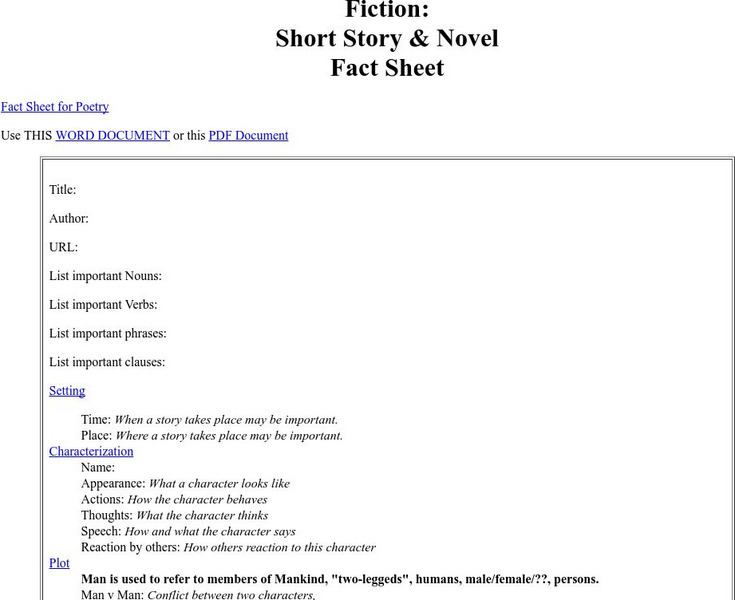Hi, what do you want to do?
Curated OER
TO LOVE, HONOR AND OBEY (ONE'S PARENTS!)
Learners examine parent-child tensions regarding obedience and communication, in order to explain the conflicts in the opening scene of King Lear. They discuss ways in which expectations for studenT obedience were different in...
Curated OER
Appreciating The Scarlet Letter
Tenth graders read the first 10 chapters of, 'The Scarlet Letter.' They utilize an assignment imbedded in this plan to research the characters and define the role each plays in the novel.
Curated OER
Forget Us Not
Learners read a literary selection about the Holocaust. They examine a website with art and poems created by students regarding this topic. Then they create poetry that demonstrates their understanding of the literary selection on the...
Curated OER
Cultural America
Seventh graders investigate the cultural differences that can be found in America. They discuss what it means to be called an American. The patterns of migration to America are discussed with the use of maps and geographical terms....
Curated OER
Build a Connection
Learners discuss their personal connections with stories they've read in the past and identify techniques to connect with more stories. They create illustrations, construct task cards, and complete sentence stems based on books they read...
Curated OER
Ways to Reinforce Learning with Meaningful Activities
There are many ways to reinforce learning with student-designed or creative assignments.
Curated OER
Figuring Out Frost
Fourth graders read "The Runaway" by Robert Frost and analyze it for its literal and symbolic meanings. They compare their personal experiences with the poet's suggestions about youthful attitudes and behaviors. Some nice worksheets are...
Curated OER
Connection Stems
Students connect their lives to a story or nonfiction text. In this reading connections lesson plan, students make text-to-self, text-to-text, and text-to-world connections as they complete connections stems based on a story.
Curated OER
"Thank You Ma'am" by Langston Hughes
Pupils use Langston Hughes' "Thank You Ma'am" as a reading and vocabulary improvement activity. In this reading and vocabulary lesson plan, students review the related vocabulary and read the poem. Pupils discuss the story elements in...
Curated OER
Evaluate the Main Characters? Problem-Solving Processes
Students read passages from several sources and evaluate the text for various criteria. In this problem solving lesson plan, students evaluate character problem solving processes after reading passages. They will use a Venn Diagram to...
Curated OER
World War II: A United Front
Young scholars interpret historical evidence presented in primary resources. For this World War II lesson, students examine racial relations during the war and then examine propaganda techniques employed by the United...
Curated OER
King Henry IV, Part 1 by William Shakespeare
In this online interactive reading comprehension worksheet, students respond to 15 multiple choice questions about Shakespeare's King Henry IV. Students may submit their answers to be scored.
TES Global
Blendspace: Types of Plot Conflict
A six-part learning module with links to texts and videos about the six basic plot conflicts in literary texts.
South Carolina Educational Television
Know It All: Types of Conflict
Students will learn about the four major types of conflict. They will use children's books to identify the types of conflict used, as well as create their own narratives using one of the types of conflict.
Sophia Learning
Sophia: Conflict Types
This slideshow lesson focuses on types of conflict including the 3 main types: internal, external, and relational. It defines internal conflict, gives ways the character could be conflicted, and provides literary examples. It lists the 4...
TeachEngineering
Teach Engineering: It Takes Two to Tangle
Students explore the theme of conflict in literature. They learn the difference between internal and external conflict and various types of conflicts, including self against self, self against other, and self against nature or machine....
Ted Nellen
Cyber English (By Ted Nellen): Conflict
This is a glossary defintion of the term "Conflict" as it pertains to the plot in fiction. It defines conflict and lists two types: internal and external and is seen in these forms: man vs man, man vs. nature, man vs self.
Texas Education Agency
Texas Gateway: Analyze the Central Characters in Literary Text/fiction
In this lesson, students will learn some ways that writers reveal the complexity of their characters. By closely analyzing one author's characters, they will come to see how their words, actions, and interactions with one another can...
Department of Defense
Do Dea: Story, Identity, Unity
Delve into the art of storytelling in this self-guided unit. Multiple topics are covered such as literary genres, the 7 elements of fiction, figurative language, theme, characterization, etc. At the end of the unit, write your own flash...
ClassFlow
Class Flow: Short Story Unit Applying Literary Terms
[Free Registration/Login Required] This flipchart is a review and assessment of a collection of short stories. The following literary terms are applied to the stories: plot structure, types of characters, characterization, irony,...
Ted Nellen
Cyber English (By Ted Nellen): Fiction: Short Story & Novel Fact Sheet
This is a short story or novel fact sheet offered as a Word document or a PDF. It includes places for title; author; URL; list of important nouns, verbs, phrases, and clauses; setting (includes definition); characterization (including...
TeachEngineering
Teach Engineering: Red Light, Green Light
Building upon their understanding of forces and Newton's laws of motion, students learn about the force of friction, specifically with respect to cars. They explore the friction between tires and the road to learn how it affects the...
ReadWriteThink
Read Write Think: Using Picture Books to Teach Plot Development and Confict Res.
Students read picture books to explore the concepts of plot development and conflict resolution. They first learn about the connections between reading and writing, and then revise their own writing. CCSS.ELA-Literacy.CCRA.R.4



























